Descriptive Writing Topics For Class 6 Format, Examples, Exercises
Descriptive writing is an important aspect of language learning that allows students to express their creativity and imagination. It is a form of writing that describes a person, place, event, or object in detail using sensory details, vivid imagery, and figurative language. In this article, we will explore some descriptive writing topics for class 6, including format, examples, and exercises.
Also Read: Descriptive Writing Class 9

Format of Descriptive Writing Topics For Class 6:
Descriptive writing follows a specific format that includes the following elements:
1. Introduction: The introduction should provide an overview of the topic and capture the reader’s attention.
2. Body Paragraphs: The body paragraphs should describe the topic in detail using sensory details, vivid imagery, and figurative language.
3. Conclusion: The conclusion should summarize the main points of the essay and leave a lasting impression on the reader.
Examples of Descriptive Writing Topics For Class 6:
Here are some examples of descriptive writing:
1. The Beach: The sun was setting, casting a warm golden glow over the calm waters of the ocean. The sound of the waves crashing against the shore was soothing, and the smell of salt water filled the air. The sand was warm and soft under my feet, and I could feel the gentle breeze blowing through my hair.
2. My Dog: My dog is a fluffy, white Pomeranian with big, brown eyes. She is always full of energy and loves to play fetch. Her fur is soft and silky, and she has a cute little button nose. Whenever I come home from school, she greets me with a wagging tail and a lick on the face.
3. My Favorite Food: My favorite food is pizza. The crust is crispy and golden, and the cheese is gooey and melted. The tomato sauce is tangy and sweet, and the toppings are always fresh and flavorful. Every bite is a burst of savory goodness.
Exercises for Descriptive Writing Topics For Class 6:
Here are some exercises to help students improve their descriptive writing skills:
1. Describe a Favorite Place: Ask students to describe their favorite place using sensory details, vivid imagery, and figurative language. Encourage them to use their five senses to create a vivid picture in the reader’s mind.
2. Describe a Person: Ask students to describe a person they admire or respect using sensory details, vivid imagery, and figurative language. Encourage them to use adjectives and similes to create a vivid portrait of the person.
3. Describe an Event: Ask students to describe an event they attended using sensory details, vivid imagery, and figurative language. Encourage them to use descriptive language to convey the atmosphere, emotions, and actions of the event.
4. Write a Short Story: Ask students to write a short story that includes descriptive writing. Encourage them to use sensory details, vivid imagery, and figurative language to create a compelling narrative.
Conclusion On Descriptive Writing Topics For Class 6
Descriptive writing is an important skill that can help students express their creativity and imagination. By using sensory details, vivid imagery, and figurative language, students can create a vivid picture in the reader’s mind. By practicing descriptive writing exercises, students can improve their writing skills and develop their own unique writing style.

The Top 20 Descriptive Paragraph Examples
Written by Dan
Last updated March 20, 2024
Are you tired of hearing your students say, “I don’t know how to write a descriptive paragraph!”? If so, you’re not alone! Writing compelling descriptions can be one of the most challenging parts for teachers and students.
But it doesn’t have to be so tricky! With suitable examples and guidance, anyone can become an expert in vividly describing people, places, things or events.
Before jumping into the deep end of resources out there, it’s a good idea for students to check out websites offering free essay samples, like StudyMoose .These platforms provide a wide range of free essays that can help students enhance their writing skills.
In this blog post, I will provide twenty stellar examples you can use as models for teaching your students how to write compelling descriptive paragraphs.
Related : For more, check out our article on Building Suspense In Writing here.
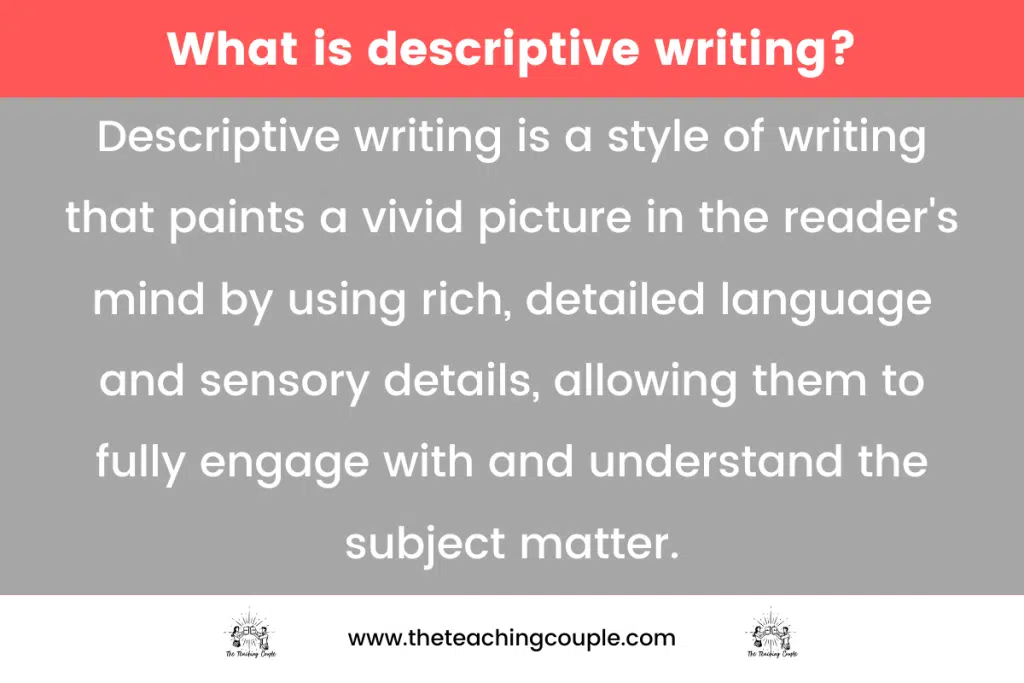
According to Grammarly , descriptive writing can enhance content, from an essay describing a historical event to a blog post narrating a personal experience.
IUP’s Writing Center further explains that effective descriptive writing evokes sights, smells, sounds, textures, and tastes, immersing readers in the narrative. But how does one master this craft?
Study.com provides a comprehensive lesson on the techniques and examples of descriptive writing, while LanguageTool offers insights into the illustrative writing style.
Table of Contents
Descriptive Paragraph Example 1:
The sun-kissed beach was a veritable haven. Soft, white sand stretched lazily from one end of the coastline to the other, inviting visitors to take off their shoes and dip their toes in the cool water.
Warm sunshine beat down on my skin as I walked along the smooth shoreline, enjoying the salty ocean breeze that greeted me with each step. In the distance, I could see boats anchored in the harbour, their masts swaying gracefully with the rhythm of the waves.
Descriptive Paragraph Example 2:
The older man shuffled slowly down the dirt road, a faded baseball cap pulled low over his eyes to shield them from the sun’s rays. He wore overalls and a flannel shirt, his hands calloused from years of hard work in the fields.
His face was craggy but kind- a life filled with stories hidden beneath the wrinkles that framed his eyes. I watched him as he walked, his steps light despite the weight of all he had seen.
Descriptive Paragraph Example 3:
The bustling city street was a melting pot of cultures, languages, and flavours. As eager shoppers stopped to examine their wares, merchants called out from their booths. Everywhere I looked, people were walking, talking, laughing- the occasional honk of a car horn punctuating the air.
The smells were a mix of mouthwatering cuisine from dozens of countries, the sound of different languages intermingling as the conversation drifted through the air.
Descriptive Paragraph Example 4:
The lush meadow was blanketed in soft green grass, punctuated with wildflowers in all rainbow colours. The sun shone brightly in the sky, warming everything beneath it with its gentle rays. In the distance, a stream babbled peacefully as birds chirped their songs from the trees that lined it.
The air was heavy with the sweet scent of honey, and I closed my eyes to take in all of its beauty.
Descriptive Paragraph Example 5:
The forest was alive with activity; small creatures skittered through the undergrowth while bright-coloured birds flitted from branch to branch overhead. A cool breeze caressed my skin and rustled through the leaves of nearby trees as I walked along the path, breathing deeply of the damp woodland air.
Everywhere I looked, lush greens and browns reminded me that life was flourishing here in this small corner of the world.
Descriptive Paragraph Example 6:
The ancient ruins surrounded a vast desert, their sand-covered stones looking out over miles of wind-swept dunes. I walked through the crumbling archway and into the courtyard, taking in the eerie silence that pervaded the entire site.
The sun beat down from above, its rays glinting off broken columns and walls that told stories of a forgotten time. Here was evidence of an ancient civilization that had disappeared into history.
Descriptive Paragraph Example 7:
The decrepit old mansion stood atop a hill like a silent sentinel watching over the valley below. Tall windows stared blankly from the walls, their glass panes long since shattered. The grounds were overgrown with weeds and wildflowers, a testament to the fact that no one had set foot here in many years.
I stepped through the doorway and into what felt like an entirely different world- a place filled with secrets and stories waiting to be discovered.
Descriptive Paragraph Example 8:
The silver moon shone brightly against the night sky, its reflection glittering on the lake’s still surface below. Fireflies sparkled around me like stars fallen from the heavens, their lights twinkling with those of distant galaxies.
Crickets chirped softly as they scuttled across my path while owls hooted in the distance. Everything felt peaceful and calm, like time had stopped to admire this magical moment.
Descriptive Paragraph Example 9:
The beach was a tranquil paradise, soft white sand stretching towards an endless blue horizon. The waves crashed gently against the shore, their foamy spray cooling my skin under the hot afternoon sun.
Seagulls hovered overhead, crying as they searched for food along the shoreline. Everywhere I looked, there was beauty; everything seemed perfect at that moment, from the towering palm trees to the sparkling sea below.
Descriptive Paragraph Example 10:
The snow-capped mountain peak rose majestically above me, its rocky sides glinting in the bright sunlight. I could feel the chill of the air around me and see my breath misting in front of me as I trudged up the steep path.
All was silent except for a few birds singing in the distance and the occasional avalanche tumbling down one of the nearby slopes. Everywhere I looked, there were breathtaking views and a sense of awe at being so close to such a powerful force of nature.

Descriptive Paragraph Example 11:
The sun was setting, painting the sky in vibrant shades of orange, pink and purple. The clouds were streaked with golden light, completing the brilliant spectacle that was taking place all around me.
I stopped to take it all in, feeling deep gratitude and awe at witnessing such a beautiful sight. All my worries seemed so far away at that moment; here, nothing else mattered but enjoying this fantastic view.
Descriptive Paragraph Example 12:
The dusty roads wound their way through the rolling hills of the countryside, lined by ancient trees whose roots had grown deep over centuries. Wildflowers flourished in splashes of colour against the backdrop of green fields and blue sky.
The air was sweet with the scent of fresh-cut hay and the buzzing of bees. There was a beauty that could only be found in nature, a timeless reminder of the power and magnificence of the world around us.
Descriptive Paragraph Example 13:
The city skyline glowed in all its glory against the night sky, its skyscrapers towering majestically above me. Cars whizzed by on crowded streets, neon signs flashing in their wake, while music drifted through the air from distant clubs and bars.
People bustled about their business with purpose and energy, carrying an infectious enthusiasm for life. Everywhere I looked, I saw evidence of progress and growth; it was a sight that reminded me just how vast and varied our world is.
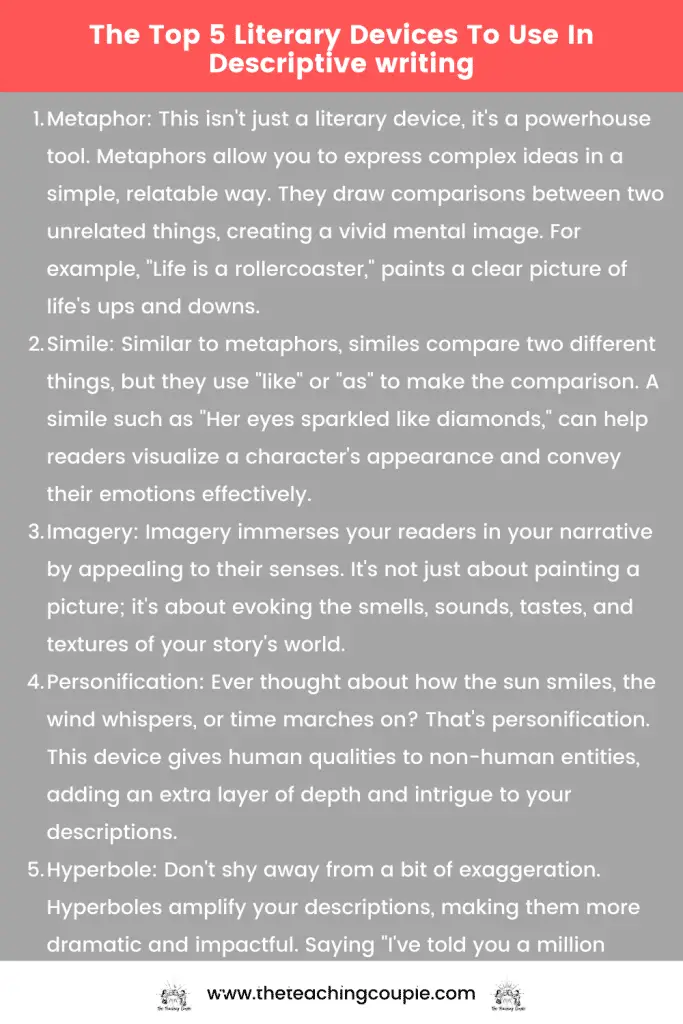
Descriptive Paragraph Example 14:
The desert stretched out before me, a vast expanse of red sand and sun-bleached rocks. The heat was oppressive but calming, the warm breeze carrying an earthy scent. In the distance, I could see dust devils whirling across the dunes, throwing up clouds of golden sand in their wake.
It felt like a place stuck in time, where one could take refuge from the frenetic pace of modern life and find solace in nature.
Descriptive Paragraph Example 15:
The forest was alive with sound and colour; birdsong filled the air while shafts of sunlight pierced through the canopy above, dappling the ground below with splashes of gold.
The trees stood tall and proud, their leaves rustling in the gentle breeze. Everywhere I looked, there was evidence of life; from the scurrying squirrels to the buzzing insects, it seemed as if everything had been frozen in perfect harmony and balance. It was an enchanting sight that made me feel profoundly alive.
Descriptive Paragraph Example 16:
The lake shimmered in the afternoon light, its still waters reflecting the clouds above. The sun shone brightly in a deep blue sky, making everything around me seem alive and vibrant. I could feel the warmth of the sand beneath my feet as I walked along the beach, watching the waves lap against the shoreline.
Everywhere I looked, there was beauty; from the towering mountains on either side to the lush greenery that covered them, it was an idyllic setting that filled my heart with joy.
Descriptive Paragraph Example 17:
The stars twinkled in all their glory above me, casting an ethereal glow over everything below. I stood in awe, my eyes searching the night sky for constellations. The moon shone brightly, its pale light illuminating the darkness and giving everything an otherworldly feel.
It was a breathtaking sight that reminded me of the power and mystery of our universe. Here I could escape from my troubles and bask in the beauty of nature’s grandeur.
Descriptive Paragraph Example 18:
The thunder roared as it rolled across the horizon, creating a rumbling sound that could be felt deep beneath my feet. Lightning crackled above, illuminating the sky with flashes of brilliant white light. The rain poured down in sheets, washing away all traces of dirt and dust from everything it touched.
This violent storm was both awe-inspiring and frightening in its intensity, a reminder of the unpredictability of nature. I felt as though I was witnessing something that could never be recreated; a moment of beauty and power that would stay with me forever.
Descriptive Paragraph Example 19:
The autumn air was crisp and clean, filled with the smell of fallen leaves and freshly cut wood. The last rays of sunlight cast an orange hue over everything, creating an ethereal atmosphere that seemed almost magical.
Everywhere I looked were vibrant red, gold, and orange shades as trees shed their leaves for the winter ahead. It was a beautiful sight that reminded me how quickly time passes and how we must cherish each moment before it slips away. It was a reminder of just how vast and varied our world is.
Descriptive Paragraph Example 20:
The snow fell softly from the sky, blanketing the world in a thick layer of white. C crystalline frost covered trees, and icicles hung from rooftops, their needles glistening in the pale moonlight.
Everything was still and silent; it felt like I was the only living soul for miles. With each breath, the cold air filled my lungs, and I savoured this moment of peace, so pure and untouched by modern life. This was nature at its finest, a reminder of how fragile our existence is.
1. What is descriptive language?
Descriptive language is a literary tool used by writers to paint vivid pictures in the reader’s mind. It involves using adjectives, adverbs, metaphors, similes, and other figurative language to describe a scene, person, or situation in detail.
2. Why is descriptive language important in descriptive paragraphs?
The essence of a descriptive paragraph lies in its ability to create a clear and vivid image in the reader’s mind. Descriptive language is instrumental in achieving this, as it adds depth, detail, and color to your writing, making it more engaging and relatable for your audience.
3. Can you give an example of descriptive language?
Absolutely! Consider this sentence: “The sun set over the ocean.” Now, let’s add some descriptive language: “The fiery sun slowly sank beneath the horizon, casting a golden glow over the tranquil, azure ocean.”
4. How can I improve my use of descriptive language?
Practice makes perfect! Try to incorporate descriptive language into your everyday writing. Read widely to expose yourself to different styles of descriptive writing. Experiment with various literary devices such as metaphors, similes, and personification.
5. Does using more adjectives and adverbs make my writing more descriptive?
Not necessarily. While adjectives and adverbs play a key role in descriptive writing, it’s essential to use them judiciously. Too many can make your writing seem overwrought and confusing. The goal should be clarity and precision.
6. How does descriptive language contribute to the tone of a paragraph?
Descriptive language can significantly influence the tone of a paragraph. For instance, using words like ‘gloomy’, ‘dreary’, or ‘haunting’ can create a dark or melancholic tone, while words like ‘vibrant’, ‘lively’, or ‘sparkling’ can evoke a more upbeat and positive tone.
7. Can descriptive language be used in all types of writing?
While descriptive language is most commonly associated with creative writing, it can be effectively used in almost all types of writing, including academic, business, and online content marketing, to engage readers and make the content more memorable. Remember, mastering descriptive language is a journey. Keep practicing, keep experimenting, and most importantly, keep having fun with your words. After all, isn’t that what writing is all about?
Related Posts

About The Author
I'm Dan Higgins, one of the faces behind The Teaching Couple. With 15 years in the education sector and a decade as a teacher, I've witnessed the highs and lows of school life. Over the years, my passion for supporting fellow teachers and making school more bearable has grown. The Teaching Couple is my platform to share strategies, tips, and insights from my journey. Together, we can shape a better school experience for all.

Join our email list to receive the latest updates.
Add your form here
Search the blog
Input your search keywords and press Enter.

Vibrant Teaching
Teaching Resources Creator and Blogger
Examples of Descriptive Writing Using the 5 Senses

What is Descriptive Writing?
Descriptive writing uses details and the five senses to describe a person, place, thing, or event. Proper word choice and the use of adjectives are very important for the reader to create a picture in their mind. Similes and onomatopoeia (sound words) are some other examples of descriptive writing.
Basic Sentence: The leaf fell off the tree.
Detailed Sentence: The yellow leaf fell off the big tree.
Descriptive Writing: SWOOSH! The smooth yellow leaf floated down from the enormous oak tree.
Using the 5 Senses
Using the five senses is one of the best ways to incorporate descriptive writing. Describing sight, smell, hearing, taste, and touch will enable the reader to envision the words and better understand the writing. Although it may be difficult to use all five senses, even just using a few will enhance the reader’s experience.
Grab your FREE 5 Senses Charts!
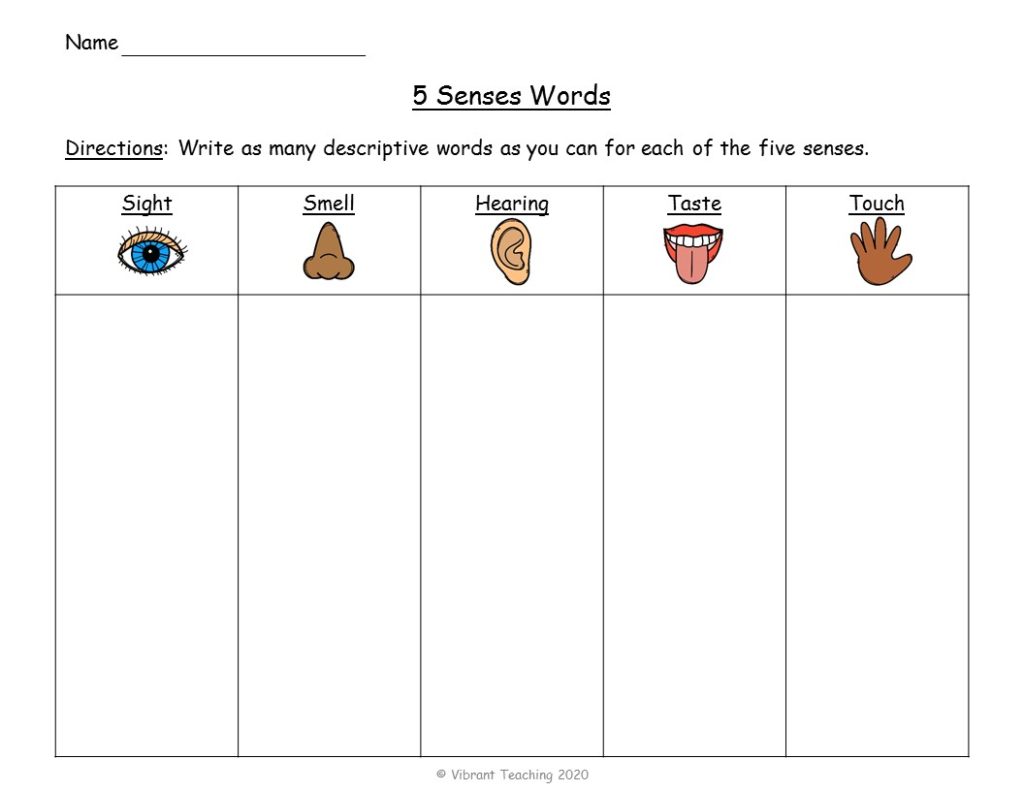
It’s fun to choose one topic and describe it in depth. Look at the list below for some examples of descriptive writing ideas for kids to try.
- Food – pumpkin pie, ice cream, hot chocolate
- Animal – dog, bird, elephant
- Season – winter, spring, summer, fall
- Holiday – Halloween, Thanksgiving, Christmas
- Place – zoo, island, school
- Event – birthday, parade, sporting event
Winter by Mrs. Sutton
Cold harsh wind engulfs me like a tornado.
White fluffy snow falls from the sky.
WHOOSH! The sound of the sled as it races past.
The smell of logs burning in the fireplace.
Sweet hot cocoa hits my tongue.

Autumn is Here by Mrs. Sutton
Bright vibrant red and yellow leaves.
The sound of leaves rustling in the wind.
Cool crisp air surrounds me.
The sweet smell of pumpkin pie as the warmth enters my mouth.
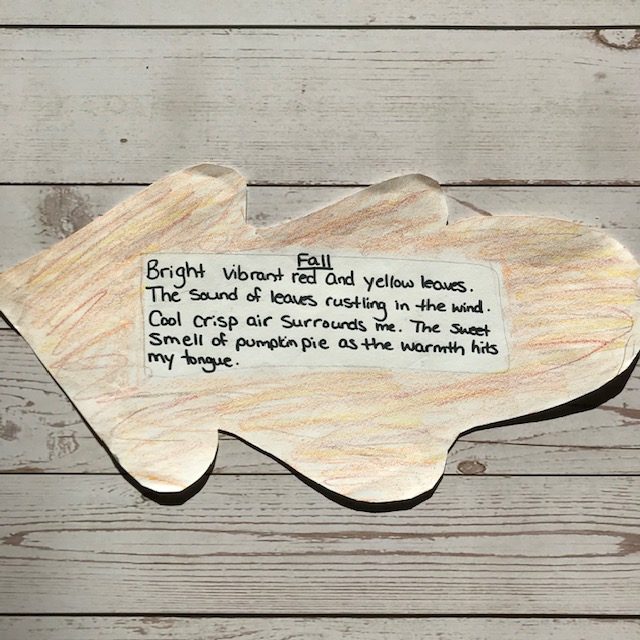
Mentor Texts
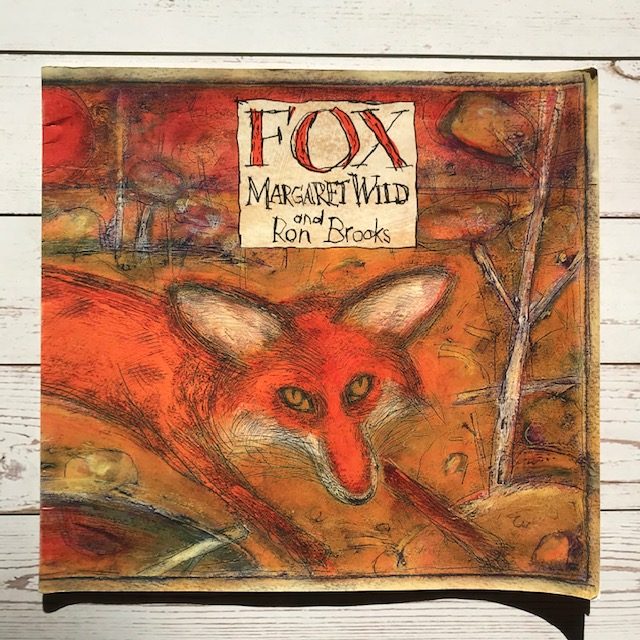
You Might Also Like:
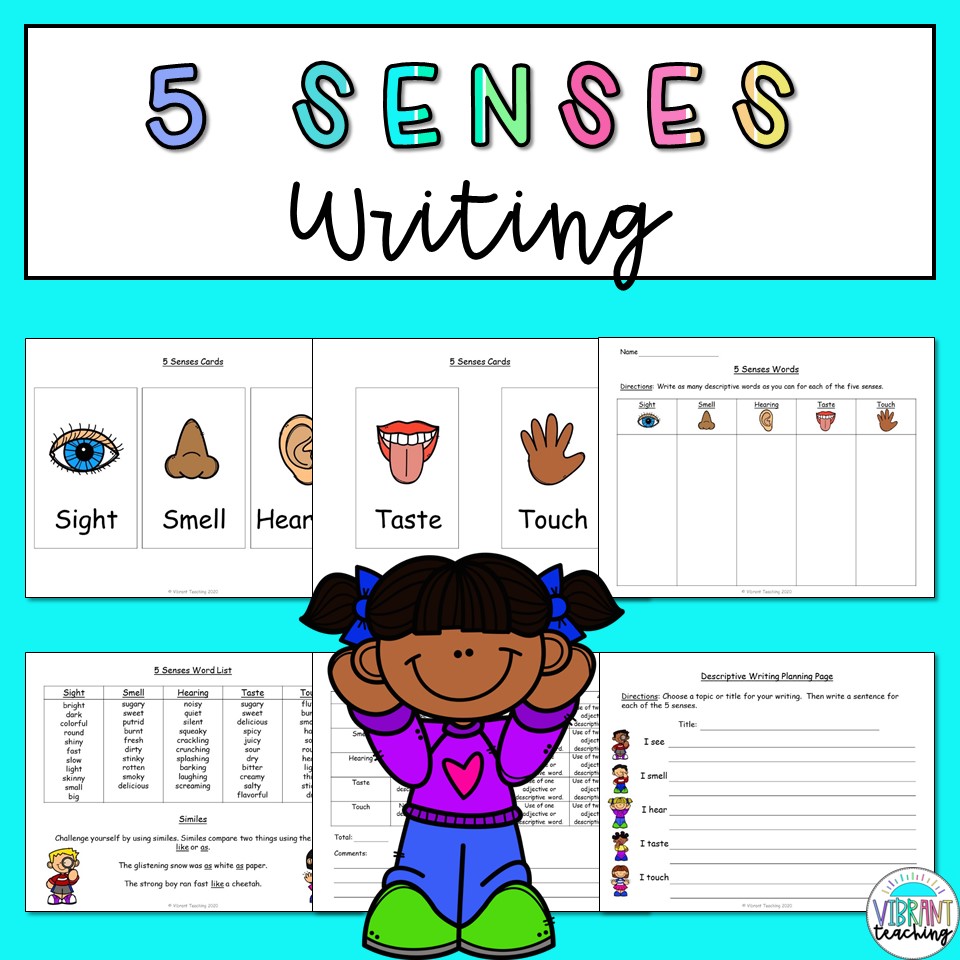
Vibrant Teaching is an Amazon Affiliate and receives a small commission for products purchased through these links. Thanks for your support !
Angela Sutton
Related posts.
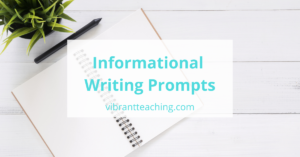
20 Prompts for Information Writing That Empower Students

Helping Students with Back to School Anxiety

Monthly Writing Prompts to Engage Students and Make Writing Fun
Hi Angela, This article was really helpful for me. Thank you so much for the best resources given.
I’m so glad this information was useful and helpful. I really appreciate your feedback!
Leave a Reply Cancel Reply
I accept the Privacy Policy

I specialize in helping elementary teachers with writing resources, tips, and ideas. My goal is to save teachers time and energy so they can be vibrant inside and outside of the classroom! Read More
SEARCH THE BLOG
Subscribe to our mailing list.
Get the news right in your inbox!
Health and Wellness
Descriptive Essay Writing
Descriptive Essay Examples

Amazing Descriptive Essay Examples for Your Help
Published on: Jun 21, 2023
Last updated on: Mar 1, 2024
-8521.jpg)
People also read
Interesting Descriptive Essay Topics - 2024
Writing a Descriptive Essay Outline - Tips & Examples
Descriptive Essay: Definition, Tips & Examples
Share this article
Descriptive essays are very commonly assigned essays. This type of essay enhances students' writing skills and allows them to think critically.
A descriptive essay is often referred to as the parent essay type. Other essays like argumentative essays, narrative essays, and expository essays fall into descriptive essays. Also, this essay helps the student enhance their ability to imagine the whole scene in mind by appealing senses.
It is assigned to high school students and all other students at different academic levels. Students make use of the human senses like touch, smell, etc., to make the descriptive essay more engaging for the readers.
On This Page On This Page -->
Examples make it easy for readers to understand things in a better way. Also, in a descriptive essay, different types of descriptions can be discussed.
Here are some amazing examples of a descriptive essay to make the concept easier for you.
Descriptive Essay Example 5 Paragraph
5 paragraphs essay writing format is the most common method of composing an essay. This format has 5 paragraphs in total. The sequence of the paragraphs is as follows;
- Introduction
- Body Paragraph 1
- Body Paragraph 2
- Body Paragraph 3
- Conclusion
Following is an example of a descriptive essay written using the famous 5 paragraph method.
5 Paragraph Descriptive Essay

Get More Examples From Our AI Essay Writer
Descriptive Essay Example About A Person
Descriptive essays are the best option when it comes to describing and writing about a person. A descriptive essay is written using the five human senses. It helps in creating a vivid image in the readerâs mind and understanding what the writer is trying to convey.
Here is one of the best descriptive essay examples about a person. Read it thoroughly and try to understand how a good descriptive essay is written on someoneâs personality.
Descriptive Essay Example About a Person
Descriptive Essay Example About A Place
If you have visited a good holiday spot or any other place and want to let your friends know about it. A descriptive essay can help you explain every detail and moment you had at that place.
Here is one of the good descriptive essay examples about a place. Use it as a sample and learn how you can write such an essay.

Tough Essay Due? Hire Tough Writers!
Descriptive Essay Example for Grade 6
Descriptive essays are frequently assigned to school students. This type of essay helps the students enhance their writing skills and helps them see things in a more analytical way.
If you are a 6 grader and looking for a good descriptive essay example, you are in the right place.
Descriptive Essay Example for Grade 7
Here is one of the best descriptive essay examples for grade 7.
Descriptive Essay Example for Grade 8
If you are looking for some amazing descriptive essay examples for grade 8, you have already found one. Look at the given example and see what a well-written descriptive essay looks like.
Descriptive Essay Example for Grade 10
Essay writing is an inevitable part of a student's academic life . No matter your grade, you will get to write some sort of essay at least once.
Here is an example of a descriptive essay writing for grade10. If you are also a student of this grade, this example might help you to complete your assignment.
Descriptive Essay Example for Grade 12
If you are a senior student and looking for some essay examples, you are exactly where you should be.
Use the below-mentioned example and learn how to write a good essay according to the instructions given to you.
Descriptive Essay Example College
Descriptive essays are a great way to teach students how they can become better writers. Writing a descriptive essay encourages them to see the world more analytically.
Below is an example that will help you and make your writing process easy.
College Descriptive Essay Example
Descriptive Essay Example for University
Descriptive essays are assigned to students at all academic levels. University students are also assigned descriptive essay writing assignments. As they are students of higher educational levels, they are often given a bit of difficult and more descriptive topics.
See the example below and know what a descriptive essay at the university level looks like.
Short Descriptive Essay Example
Every time a descriptive essay isn't written in detail. It depends on the topic of how long the essay will be.
For instance, look at one of the short descriptive essay examples given below. See how the writer has conveyed the concept in a composed way.
Objective Descriptive Essay Example
When writing an objective description essay, you focus on describing the object without conveying your emotions, feelings, or personal reactions. The writer uses sight, sound, or touch for readers' minds to bring life into pictures that were painted by words.
Here is an example that you can use for your help.
Narrative and Descriptive Essay Example
A narrative descriptive essay can be a great way to share your experiences with others. It is a story that teaches a lesson you have learned. The following is an example of a perfect narrative descriptive essay to help you get started.
Paper Due? Why Suffer? That's our Job!
How to Start a Descriptive Essay? - Example
If you don't know how to start your descriptive essay, check this example and create a perfect one.
How to Start a Descriptive Essay - Example
Subjective Descriptive Essay Example
It is a common concept that a descriptive essay revolves around one subject. Be it a place, person, event, or any other object you can think of.
Following is one of the subjective descriptive, easy examples. Use it as a guide to writing an effective descriptive essay yourself.
Writing a descriptive essay is a time-consuming yet tricky task. It needs some very strong writing, analytical, and critical thinking skills. Also, this is a type of essay that a student can not avoid and bypass.
But if you think wisely, work smart, and stay calm, you can get over it easily. Learn how to write a descriptive essay from a short guide given below.
How to Write a Descriptive Essay?
A writer writes a descriptive essay from their knowledge and imaginative mind. In this essay, the writer describes what he has seen or experienced, or ever heard from someone. For a descriptive essay, it is important to stay focused on one point. Also, the writer should use figurative language so that the reader can imagine the situation in mind.
The following are some very basic yet important steps that can help you write an amazing descriptive essay easily.
- Choose a Topic
For a descriptive essay, you must choose a vast topic to allow you to express yourself freely. Also, make sure that the topic you choose is not overdone. An overdone will not grab the attention of your intended audience. Check out our descriptive essay topics blog for a variety of intriguing topic suggestions.
- Create a Strong Thesis Statement
A thesis statement is the essence of any academic writing. When you select the descriptive essay topic, then you create a strong thesis statement for your essay.
A thesis statement is a sentence or two that explains the whole idea of your essay to the reader. It is stated in the introductory paragraph of the essay. The word choice for creating the thesis statement must be very expressive, composed, and meaningful. Also, use vivid language for the thesis statement.
- Collect the Necessary Information
Once you have created the thesis statement and are done writing your essay introduction . Now, it's time to move toward the body paragraphs.
Collect all necessary information related to your topic. You would be adding this information to your essay to support your thesis statement. Make sure that you collect information from authentic sources.
To enhance your essay, make use of some adjectives and adverbs. To make your descriptive essay more vivid, try to incorporate sensory details like touch, taste, sight, and smell.
- Create a Descriptive Essay Outline
An outline is yet another necessary element of your college essay. By reading the descriptive essay outline , the reader feels a sense of logic and a guide for the essay.
In the outline, you need to write an introduction, thesis statement, body paragraphs and end up with a formal conclusion.
Proofreading is a simple procedure in which the writer revises the written essay. This is done in order to rectify the document for any kind of spelling or grammatical mistakes. Thus, proofreading makes high-quality content and gives a professional touch to it.
You might be uncertain about writing a good enough descriptive essay and impress your teacher. However, it is very common, so you do not need to stress out.
Hit us up at CollegeEssay.org and get an essay written by our professional descriptive essay writers. Our essay writing service for students aims to help clients in every way possible and ease their stress. Get in touch with our customer support team, and they will take care of all your queries related to your writing.
You can always enhance your writing skills by leveraging the power of our AI essay writing tools .
Place your order now and let all your stress go away in a blink!
Barbara P (Literature)
Barbara is a highly educated and qualified author with a Ph.D. in public health from an Ivy League university. She has spent a significant amount of time working in the medical field, conducting a thorough study on a variety of health issues. Her work has been published in several major publications.
Paper Due? Why Suffer? That’s our Job!

Keep reading

Legal & Policies
- Privacy Policy
- Cookies Policy
- Terms of Use
- Refunds & Cancellations
- Our Writers
- Success Stories
- Our Guarantees
- Affiliate Program
- Referral Program
- AI Essay Writer
Disclaimer: All client orders are completed by our team of highly qualified human writers. The essays and papers provided by us are not to be used for submission but rather as learning models only.

Descriptive Writing
Our Descriptive Writing lesson plan for grades 4-6 teaches students to develop the skills needed for descriptive writing. Students practice using the strategies taught in this lesson to enhance their writing.
Description
Additional information.
Our Descriptive Writing lesson plan for grades 4-6 helps students develop the skills needed for descriptive writing. Students are asked to use both their creativity and their technical writing skills in order to write descriptive sentences, paragraphs, and even essays. Students work collaboratively on an assignment in which one child writes a detailed description of a scene or object and the other student draws it; this allows the students to see how much detail a reader can glean from their writing. Students are also asked to work independently to make boring descriptions more interesting.
At the end of the lesson, students will be able to use precise words and phrases, descriptive details, and sensory language to convey experiences and events.
Thank you for submitting a review!
Your input is very much appreciated. Share it with your friends so they can enjoy it too!
Descriptive writing
Really useful and helpful to plan the descriptive writing.
Descriptive Writing Material
This was really helpful, however it would have been better to have answer keys provided.
Excellent worksheets
The descriptive writing worksheets are easy and inspiring for my student. They really help her to apply descriptive writing techniques in her own writing.
Excellent program and very easy for my child to understand!
Great lesson!
Students were engaged and interested. Thank you
Related products

Man o’ Wars
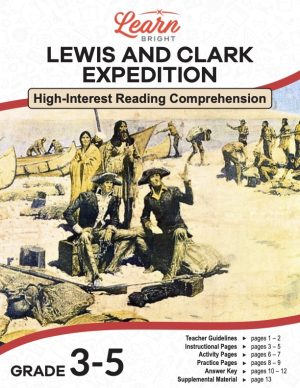
Lewis and Clark Expedition

Careers: Archaeologist
Make your life easier with our lesson plans, stay up-to-date with new lessons.

- Lesson Plans
- For Teachers
© 2024 Learn Bright. All rights reserved. Terms and Conditions. Privacy Policy.
- Sign Up for Free
Descriptive Writing Examples: A Guide to Mastering the Art of Description

Imagine an article so teeming with life that it seems sentient.
As you consume its words, it seizes your attention and transports you to a world where scaly dragons slice through the sky as sharply as the knight’s blade that threatens their existence.
Okay, this post may not be that invigorating, but let’s see how we can bring our words to life through descriptive writing….
The Draw of Descriptive Writing
Descriptive writing is a powerful tool that enables you to create vivid images in your reader’s mind.
When you use figurative language and sensory details, it creates an immersive experience for your readers, drawing them into your narrative more fully.
The use of metaphors, for example, helps you illustrate similarities in ways that are easily understood:
“Her eyes were radiant stars in the night sky.”
Beyond using metapors, descriptive writing highlights emotion, describing it in fine detail.
You can evoke emotion through the reactions of your characters and the atmosphere you create.
Instead of stating that a character is sad, describe their trembling lip, downcast eyes, or the heavy weight on their shoulders.
Incorporate figurative language, such as similes and personification, to convey more depth in your descriptions.
Similes make explicit comparisons:
“The leaves rustled like whispers in the night.”
Personification attributes human characteristics to non-human things:
“The wind howled in frustration.”
Engage your reader’s senses by describing not only how things look but also how they sound, feel, taste, and smell.
For instance:
- describe the warmth of a crackling fireplace,
- the aroma of freshly baked bread,
- or the sound of rain beating against the window.
Finally, include specific sensory details so that your reader can easily envision what you’re trying to describe. Instead of simply stating that a room was messy, describe the piles of clothes on the floor, the papers strewn about, and the half-empty coffee mugs on the cluttered desk.
By combining these elements in your descriptive writing, you’ll create a rich and engaging experience that will captivate your readers and leave lasting impressions.
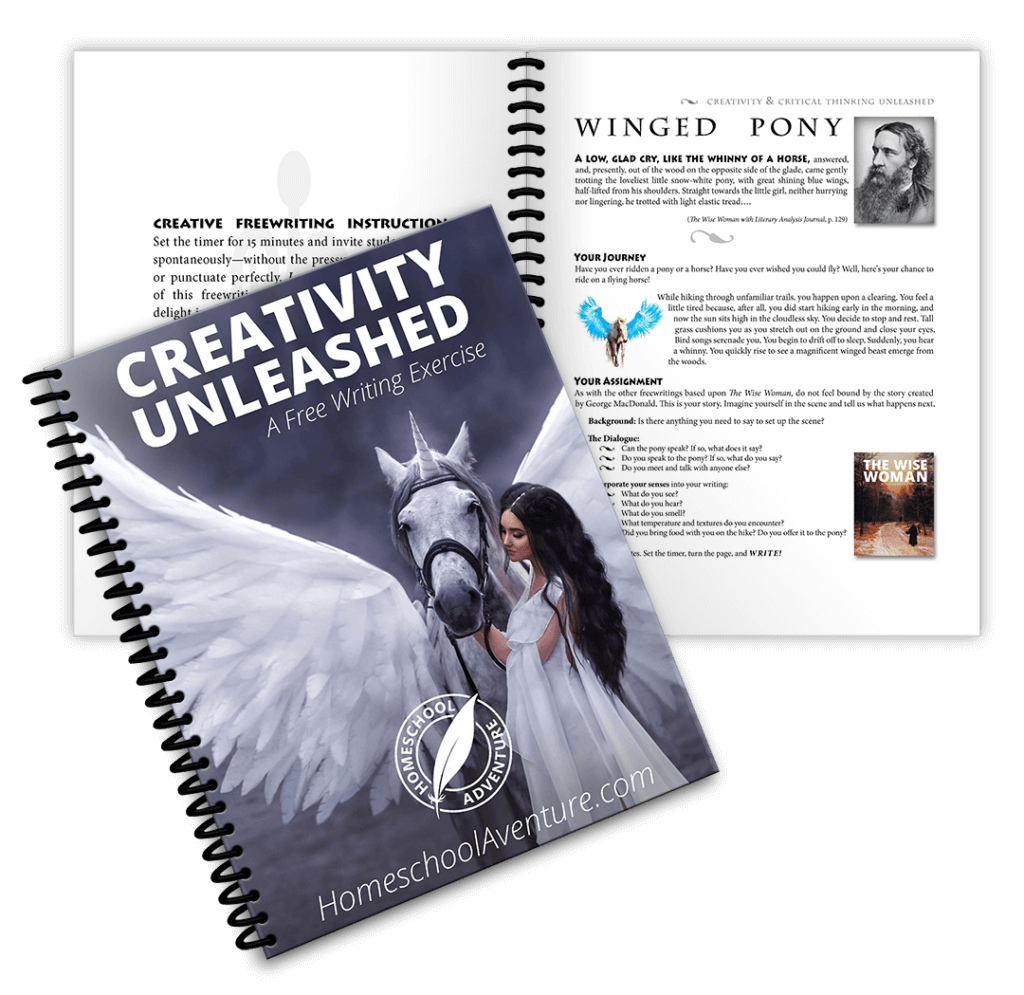
Get a free writing exercise (includes prompts)!
Key elements of descriptive writing.
First, provide a clear setting . Inform your readers of the location and time period of your scene.
Whether you’re describing a busy city street or a serene forest, give a clear context that allows your readers to immerse themselves within the locale.
Make sure to address the surroundings and any relevant objects that contribute to the setting.
Next, organize your description in a logical order . Guide your reader through the scene by providing a clear sequencing of events, objects, or characters.
This can be done chronologically, spatially, or in order of importance to the story.
Having a clear flow of information ensures that your reader can easily follow the narrative—without getting lost in the details.
Lastly, it’s important to be clear and concise throughout the writing process. Being detailed doesn’t mean being overly wordy.
Efficiently and effectively convey your message to the reader.
Remember to keep the focus on the scene, setting, and characters, and avoid inserting unnecessary opinions or judgments.
A consistent and informative tone allows your reader to fully appreciate and understand your writing.
The Role of Language Selection
When writing descriptive paragraphs , the use of various linguistic devices helps paint a vivid picture in the reader’s mind.
Let’s explore how some of these devices can enhance your writing.
Adjectives enrich your writing by adding details and depth to nouns. Be intentional with the choice of your adjectives. Opt for compelling descriptors to create a lasting impression.
Verdant has more pizazz than green , don’t you think?
Verbs and adverbs give life and movement to your writing.
Avoid repetition, and be precise with your verb or adverb word choice. Instead of saying “walked slowly,” you could use “sauntered” or “strolled.”
Include specific details that help your reader perceive a scene exactly as you do. It might be the texture of a fabric, a particular smell, or the way light reflects off a surface.
Opt for expressive terms, and utilize devices such as metaphors and personification to create strong mental images.
Lastly, onomatopoeia is a useful tool in descriptive writing, involving words that represent sounds, such as “buzz,” “sizzle,” or “whisper.”
They help aurally immerse your readers in the scene and make the experience more engaging.
Remember, it’s essential to balance these language features to effectively maintain your reader’s interest.
3 Examples of Descriptive Writing
1. descriptive writing sample about a place.
Imagine you’re walking through an enchanting forest. The sunlight filters through the dense canopy, casting dappled shadows on the soft, mossy ground.
Surrounding you, tall trees stretch towards the sky, their bark rough and gnarled, providing a home for scurrying beetles. A gentle breeze brings the scent of fresh pine and damp earth, stirring your senses and enveloping you in the forest’s calming embrace.
As you continue further, a babbling brook emerges, its crystal-clear water reflecting the sky above. The tranquil sound of the water brings a sense of serenity to the enchanted forest.
2. Descriptive Writing Sample About a Person
Consider a grandmother you know—someone whose face has been etched with the wisdom of a long life. Her once-dark hair—now a silver cascade—frames her face, showcasing the crinkles around her worn, yet joy-filled eyes.
Her hands, strong and calloused from decades of hard work, are nevertheless gentle, cradling a grandchild or cupping the cheek of a loved one.
When she speaks, her voice is like the rustling of leaves, soft yet strong, exuding age, wisdom, and a hint of mischievous humor.
Her smile is a treasure that spreads warmth to everyone she encounters.
3. Descriptive Writing Sample About Emotion
Imagine the sensation of excitement—that fluttering in your stomach as your heart races. It’s as if electricity buzzes beneath your skin.
Your hands tremble slightly as your breathing intensifies. Your thoughts race, jumping from one subject to another as a smile spreads across your face.
It’s a contagious feeling that spreads like a wave, refreshing those around you.
Did these short samples help you better understand descriptive writing? Now it’s your turn! Practice with this free creative writing exercise:
If you have an elementary-aged student, try these creative writing topics to get him or her started.
Frequently Asked Questions
How can i improve my descriptive writing skills.
To improve your descriptive writing skills, practice is essential. Write regularly, describing various objects, settings, and people.
Also, study examples of descriptive writing to analyze how other authors create vivid imagery. Experiment with various literary devices, such as similes, metaphors, and personification. Remember, it’s okay—even highly recommended—to revise your work and refine your descriptions.
What are some techniques used in descriptive writing?
Some common techniques used in descriptive writing include:
- Imagery : Use vivid language to create mental images that help readers visualize the subject.
- Sensory details : Engage the reader’s senses (sight, sound, smell, taste, touch) by providing specific details.
- Similes and metaphors : These comparisons help readers understand complex subjects by comparing them to familiar, simpler objects.
- Personification : Bring stories to life by giving human characteristics to non-human objects.
- Precise language : Use clear and accurate words to describe the subject effectively.
- Varied sentence structure : Mix short and long sentences to maintain the reader’s interest and provide a natural flow to your writing.
How does descriptive writing differ between grade levels?
Descriptive writing expectations change as students progress through grade levels:
- Elementary grades : At younger ages, students are encouraged to use simple, familiar language to describe objects, scenes, and characters. They should focus on basic descriptive techniques such as adjectives and sensory details. Consider picture-based writing prompts for this age group.
- Middle grades : As students advance, they begin to incorporate more complex language, literary devices, and varied sentence structures. They also start to tailor their descriptions to their audience and purpose.
- High school : High school students refine their descriptive writing skills by using more sophisticated vocabulary, creating nuanced images, and developing their personal writing style. They are expected to demonstrate a mastery of descriptive techniques and employ them effectively across various writing genres.
About The Author

Jordan Mitchell
- Skip to primary navigation
- Skip to main content
- Skip to primary sidebar
- Skip to footer
Descriptive Writing: Definition, Tips, Examples, and Exercises
Descriptive writing is about using the power of words to arouse the imagination, capture the attention, and create a lasting impact in the mind of the reader. In this article, you'll learn how to employ descriptive elements in your writing, tips to enhance your descriptive writing skills, and some exercises to better yourself at it.

Descriptive writing is about using the power of words to arouse the imagination, capture the attention, and create a lasting impact in the mind of the reader. In this article, you’ll learn how to employ descriptive elements in your writing, tips to enhance your descriptive writing skills, and some exercises to better yourself at it.
Read the two sentences given below:
- I felt tired at work today.
- As the day wore on at work, I felt a cramp beginning to form at the nape of my neck, my eyes began to feel droopy, and the computer screen in front of me began blurring.
Which one of the two do you find more interesting to read? Most definitely the second one. This is because, while the first sentence merely tells you directly that ‘you felt tired at work today’, the second one explains the same experience in a much more vivid and relatable manner.
From this you can see that even something as simple as the above sentence can be transformed using literary devices that aid visualization, into something that someone can relate to. This is what descriptive writing is all about: heightening the sense of perception and alluring your reader to read ahead, because you have so much more to say.
Good Examples of Descriptive Writing
Given below are a couple of good pieces of descriptive writing from authors who know their business.
‘But the door slid slowly open before Lupin could reach it. Standing in the doorway, illuminated by the shivering flames in Lupin’s hand, was a cloaked figure that towered to the ceiling. Its face was completely hidden beneath its hood. Harry’s eyes darted downwards, and what he saw made his stomach contract. There was a hand protruding from the cloak and it was glistening, greyish, slimy-looking and scabbed, like something dead that had decayed in water…’ – Harry Potter and the Prisoner of Azkaban by J.K. Rowling
‘I don’t know what I’d expected but it was something different than I saw. She looked unexpectedly young. Or, I suppose said better, she looked unexpectedly “not old”. Her hair, which was completely white, had a yellowish cast that could almost have been mistaken for a pale blond, and it was loose around her shoulders. And long. Longer than mine. No doubt she normally wore it pulled up in a bun, and such a style would have given her a more predictable little-old-lady look, but the way it was here now, parted on the side – long, loose, and straight – she seemed ageless as an ancient sculpture. This sense was enhanced by her skin. Though it had the fragile crepeyness of age, she had few wrinkles, especially across her forehead, which was smooth to a point of being almost waxy looking. She was of obvious northern Germanic heritage, with pale eyes and prominent features. Although she was not overweight, her bones were big and blunt, giving the impression of a tall, sturdy woman.’ – Twilight Children by Torey Hayden
Why be Descriptive While Writing?
- The purpose of descriptive writing is to inspire imagination. When you put your mind into making a piece of writing more descriptive, you automatically begin to pay attention to detail and refine your perception about things. You begin to imagine them as much more than, say a party hat or a hard-bound book . You begin to look at them as a tall, pink, pointed paper hat with tassels , and a book that had a gleaming golden spine, and weighed a few good pounds .
- The next, and probably the most important benefit of descriptive writing is that in the process of trying to make the reader visualize what you want to say, you tend to use more interesting words. You want to convey a mental picture to your reader. So you’re bound to use words that might be unconventional or less-used. You will want to find words that exactly describe what you want to say, and will look for different words that mean the same. This will help you suitably build your vocabulary.
- The success of descriptive writing lies in the details. The more detailed your depiction of a plot or a character or a place is, the more you engross your reader. You become a keen observer and minder of details. You pay attention to the tiniest bits of information and appearance, which in turn helps you transfer the details into your writing.
- Since you have picked something to describe and have observed all its details, you are sure to understand the subject better. You may even come across bits and pieces that you may have missed the first time you looked at the object/subject in question. Thoroughly understanding what you’re going to write about is exceedingly important to the process of writing about it.
Tips you Can Use Identify what you’re about to describe
As you start with descriptive writing, identify exactly what you are setting out to describe. Usually, a descriptive piece will include the depiction of a person, a place, an experience, a situation, and the like. Anything that you experience or perceive about your subject can be the focal point of your descriptive writing. You build a backdrop by identifying an aspect of a subject that you want to describe.
Decide why you’re describing that particular aspect
While it can be a wonderful creative exercise to simply describe anything you observe, in descriptive writing, there is often a specific reason to describe whatever you have set out to describe. Tapping this reason can help you keep the description focused and infuse your language with the particular emotion or perspective that you want to convey to your readers.
Maintain a proper chronology/sequence Sometimes, you may get so caught up in making your work colorful and creative that you may end up having a mash-up of descriptions that follow no particular order. This will render the effort of writing useless as the various descriptions will simply confuse the reader. For instance, if you want to describe characters in a particular situation, begin by describing the setting, then proceed to the most important character of that particular situation, and then to the least important one (if necessary).
Use Imagery Imagery is the best tool you can employ in descriptive writing. Since you cannot show your reader what you are imagining, you need to paint a picture with words. You need to make the depiction of your imagination so potent that your reader will instantly be able to visualize what you are describing. However, don’t go overboard. Make sure that the focus does not dwindle stray. Keep your descriptions specific to the subject in question. The writing must be able to draw in the reader; hence, the writer should say things that the reader can relate to or empathize with. An introductory backdrop can often provide an effective setting for the remaining part of the piece. Great descriptive writing has the ability to lure the reader, enticing him or her to continue reading right to the end. While giving the details is important, it is how they are presented that makes the difference.
Hone the senses One of the most effective ways to make the experience you are describing vivid for your reader is to use the five senses: smell, sight, sound, taste, and touch. When the descriptions are focused on the senses, you provide specific and vivid details in such a way that it shows your reader what you are describing. So, when you describe a subject, depict it in such a manner that it involves the reader’s possible sensory interpretations. It must make the reader imagine what he would see, hear, smell, taste, or feel when he reads what you have written.
She gently squeezed the juice out of the plump, red tomato. She blended this juice into the simmering mix of golden-brown onions and garlic in the pan, and watched as they melded into each other. She then added the spice mixture that she had prepared, and the air was permeated with a mouth-watering aroma.
Use strong nouns and verbs effectively, adjectives intelligently It is true that the purpose of adjectives is to describe a subject, but overuse of adjectives in descriptive writing can render the piece shallow and hollow. Hence, make it a point to use other parts of speech to express the same sentiment. You’ll be surprised how effectively nouns, verbs and adverbs can be used to describe something, sometimes even better than adjectives alone. For instance, look at the two sentences below.
- The flowers were as fresh as the morning dew.
- The flowers had a freshness that could only equal that of the glistening morning dew.
The first sentence has used an adjective (fresh) to describe the flowers. It is a good description too, because the comparison to morning dew is something that will immediately put the reader in the sense of mind that you want. The second sentence too has compared the freshness to morning dew, but has used a noun (freshness) and a verb (equal) to do so, and in the process has probably enticed the reader to continue reading, more than the first sentence.
Pick related words Before you actually begin writing, it is always a good idea to build a word bank of related words and ideas. For instance, if you are going to be describing a flower arrangement, you could jot down a few ideas before you start describing it, like: vase, color, types of flowers, leaves, stem, style, shape, fresh, etc. Once you have these basic words, you could start descriptive sentences for each one. Then, carry on from there.
Display passion Impact is what you’re looking to create in the minds of your readers. You want your readers to relate and empathize with what you’re writing. This will be close to impossible if your work does not reflect the passion that you feel for it. Make them feel what you feel with the words you write. Language that relates to powerful emotions such as love, hatred, admiration, disgust, etc., can convey the range and intensity of the sentiment that you are trying to express. Use them to your favor and get the desired effect.
Exercises to Enhance Descriptive Writing
Given below are some simple, yet effective exercises that you can use to better yourself at descriptive writing.
Exercise 1 Decide on an everyday action, say ‘making a pot of coffee’ and write about it in a descriptive manner. Give yourself 3 words that you’re not allowed to use while writing about it. You’ll see yourself reaching for the thesaurus, which will help improve your vocabulary.
Exercise 2 Pick random objects like a hat, a burger, a chair, etc., and place them before you. Enlist the different names that these objects can be called. Describe each of the objects in sentences that have more than 15 words each. Be as imaginative as you can.
Get your ‘assignments’ read by an objective person to see if they can relate to and understand properly what you have tried to convey.
Make descriptive writing a rewarding experience, both for your reader and yourself. If you like what you write, chances are that your reader will too. As is evident, having a comprehensive vocabulary is the key to good descriptive writing. But mere vocabulary will fall short if your piece lacks passion, logic and interest. The trouble is that it can easily become an incoherent rambling of senses and emotions. To avoid that, present what you are writing about in a logical and organized sequence of thoughts, so that the reader comes away from it with a cogent sense of what you have attempted to describe.
Like it? Share it!
Get Updates Right to Your Inbox
Further insights.

Privacy Overview
Descriptive Writing - English Language for Grade 6 - Grade 6 - Notes, Videos & Tests
Part of the course, descriptive writing study material, other chapters in english language for grade 6, top courses for grade 6.

Importance of Descriptive Writing Grade 6
Descriptive writing notes free pdf download, important questions for descriptive writing, descriptive writing practice questions, welcome back, create your account for free.

Forgot Password
Unattempted tests, change country.
Have a language expert improve your writing
Run a free plagiarism check in 10 minutes, generate accurate citations for free.
- Knowledge Base
- How to write a descriptive essay | Example & tips
How to Write a Descriptive Essay | Example & Tips
Published on July 30, 2020 by Jack Caulfield . Revised on August 14, 2023.
A descriptive essay gives a vivid, detailed description of something—generally a place or object, but possibly something more abstract like an emotion. This type of essay , like the narrative essay , is more creative than most academic writing .
Instantly correct all language mistakes in your text
Upload your document to correct all your mistakes in minutes

Table of contents
Descriptive essay topics, tips for writing descriptively, descriptive essay example, other interesting articles, frequently asked questions about descriptive essays.
When you are assigned a descriptive essay, you’ll normally be given a specific prompt or choice of prompts. They will often ask you to describe something from your own experience.
- Describe a place you love to spend time in.
- Describe an object that has sentimental value for you.
You might also be asked to describe something outside your own experience, in which case you’ll have to use your imagination.
- Describe the experience of a soldier in the trenches of World War I.
- Describe what it might be like to live on another planet.
Sometimes you’ll be asked to describe something more abstract, like an emotion.
If you’re not given a specific prompt, try to think of something you feel confident describing in detail. Think of objects and places you know well, that provoke specific feelings or sensations, and that you can describe in an interesting way.
Receive feedback on language, structure, and formatting
Professional editors proofread and edit your paper by focusing on:
- Academic style
- Vague sentences
- Style consistency
See an example

The key to writing an effective descriptive essay is to find ways of bringing your subject to life for the reader. You’re not limited to providing a literal description as you would be in more formal essay types.
Make use of figurative language, sensory details, and strong word choices to create a memorable description.
Use figurative language
Figurative language consists of devices like metaphor and simile that use words in non-literal ways to create a memorable effect. This is essential in a descriptive essay; it’s what gives your writing its creative edge and makes your description unique.
Take the following description of a park.
This tells us something about the place, but it’s a bit too literal and not likely to be memorable.
If we want to make the description more likely to stick in the reader’s mind, we can use some figurative language.
Here we have used a simile to compare the park to a face and the trees to facial hair. This is memorable because it’s not what the reader expects; it makes them look at the park from a different angle.
You don’t have to fill every sentence with figurative language, but using these devices in an original way at various points throughout your essay will keep the reader engaged and convey your unique perspective on your subject.
Use your senses
Another key aspect of descriptive writing is the use of sensory details. This means referring not only to what something looks like, but also to smell, sound, touch, and taste.
Obviously not all senses will apply to every subject, but it’s always a good idea to explore what’s interesting about your subject beyond just what it looks like.
Even when your subject is more abstract, you might find a way to incorporate the senses more metaphorically, as in this descriptive essay about fear.
Choose the right words
Writing descriptively involves choosing your words carefully. The use of effective adjectives is important, but so is your choice of adverbs , verbs , and even nouns.
It’s easy to end up using clichéd phrases—“cold as ice,” “free as a bird”—but try to reflect further and make more precise, original word choices. Clichés provide conventional ways of describing things, but they don’t tell the reader anything about your unique perspective on what you’re describing.
Try looking over your sentences to find places where a different word would convey your impression more precisely or vividly. Using a thesaurus can help you find alternative word choices.
- My cat runs across the garden quickly and jumps onto the fence to watch it from above.
- My cat crosses the garden nimbly and leaps onto the fence to survey it from above.
However, exercise care in your choices; don’t just look for the most impressive-looking synonym you can find for every word. Overuse of a thesaurus can result in ridiculous sentences like this one:
- My feline perambulates the allotment proficiently and capers atop the palisade to regard it from aloft.
An example of a short descriptive essay, written in response to the prompt “Describe a place you love to spend time in,” is shown below.
Hover over different parts of the text to see how a descriptive essay works.
On Sunday afternoons I like to spend my time in the garden behind my house. The garden is narrow but long, a corridor of green extending from the back of the house, and I sit on a lawn chair at the far end to read and relax. I am in my small peaceful paradise: the shade of the tree, the feel of the grass on my feet, the gentle activity of the fish in the pond beside me.
My cat crosses the garden nimbly and leaps onto the fence to survey it from above. From his perch he can watch over his little kingdom and keep an eye on the neighbours. He does this until the barking of next door’s dog scares him from his post and he bolts for the cat flap to govern from the safety of the kitchen.
With that, I am left alone with the fish, whose whole world is the pond by my feet. The fish explore the pond every day as if for the first time, prodding and inspecting every stone. I sometimes feel the same about sitting here in the garden; I know the place better than anyone, but whenever I return I still feel compelled to pay attention to all its details and novelties—a new bird perched in the tree, the growth of the grass, and the movement of the insects it shelters…
Sitting out in the garden, I feel serene. I feel at home. And yet I always feel there is more to discover. The bounds of my garden may be small, but there is a whole world contained within it, and it is one I will never get tired of inhabiting.
If you want to know more about AI tools , college essays , or fallacies make sure to check out some of our other articles with explanations and examples or go directly to our tools!
- Ad hominem fallacy
- Post hoc fallacy
- Appeal to authority fallacy
- False cause fallacy
- Sunk cost fallacy
College essays
- Choosing Essay Topic
- Write a College Essay
- Write a Diversity Essay
- College Essay Format & Structure
- Comparing and Contrasting in an Essay
(AI) Tools
- Grammar Checker
- Paraphrasing Tool
- Text Summarizer
- AI Detector
- Plagiarism Checker
- Citation Generator
Here's why students love Scribbr's proofreading services
Discover proofreading & editing
The key difference is that a narrative essay is designed to tell a complete story, while a descriptive essay is meant to convey an intense description of a particular place, object, or concept.
Narrative and descriptive essays both allow you to write more personally and creatively than other kinds of essays , and similar writing skills can apply to both.
If you’re not given a specific prompt for your descriptive essay , think about places and objects you know well, that you can think of interesting ways to describe, or that have strong personal significance for you.
The best kind of object for a descriptive essay is one specific enough that you can describe its particular features in detail—don’t choose something too vague or general.
Cite this Scribbr article
If you want to cite this source, you can copy and paste the citation or click the “Cite this Scribbr article” button to automatically add the citation to our free Citation Generator.
Caulfield, J. (2023, August 14). How to Write a Descriptive Essay | Example & Tips. Scribbr. Retrieved April 5, 2024, from https://www.scribbr.com/academic-essay/descriptive-essay/
Is this article helpful?

Jack Caulfield
Other students also liked, how to write a narrative essay | example & tips, how to write a literary analysis essay | a step-by-step guide, how to write an expository essay, "i thought ai proofreading was useless but..".
I've been using Scribbr for years now and I know it's a service that won't disappoint. It does a good job spotting mistakes”
Delightful Descriptive Writing Exercises and Worksheets
Descriptive writing is an attempt to give a clear description of people, places, objects, or events using descriptive language and informative details. Descriptive writing exercises can include:
- brainstorming
- word sorting
- sentence writing with pictures
- transitions exercises
1 Descriptive essay outline template
This is an essay outline worksheet to help students focus on organization and planning when preparing to write essays. It helps them write clearly and logically.
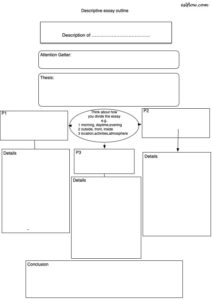
Descriptive essay outline template (PDF)
2 Brainstorming for a descriptive essay about a place
This is an English language writing exercise for students to brainstorm ideas for a descriptive essay.
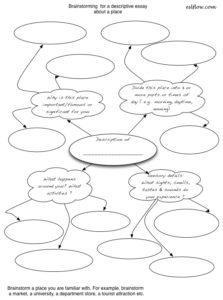
Brainstorming descriptive writing ideas (PDF)
3 Descriptive writing word sorting (with answers)
This is an exercise that helps students expand their vocabulary and shows them that there are many words available to help them write more creatively and with more attention to detail.

Descriptive writing word sorting (PDF)
4 Essential shapes vocabulary
This worksheet is designed to help students learning English become familiar with vocabulary for shapes. Students match the vocabulary to the pictures.

(download PDF)
Related Resources:
6 narrative essay writing templates and worksheets
8 comparison/contrast templates and exercises
10 cause/effect writing activities
11 essential basic exercises for paragraph/essay writing
3 kinds of exercises for teaching transitions
5 Descriptive sentences practice
This is an English language writing exercise for students to practice writing descriptive sentences. Students look at the pictures and try to write between two and five sentences.
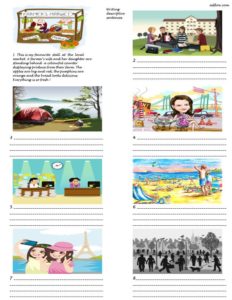
Writing descriptive sentences (PDF)
6 The Weekend Market (descriptive essay transitions with answers)
This is a transitions and linking words exercise for a descriptive essay. Well placed transitions help make essays easier to read and understand.
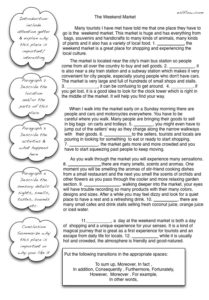
Descriptive essay transitions exercise (PDF)
(see the video on YouTube)
7 Descriptive Paragraphs ( transitions exercise with answers)
This is an English language exercise to help students understand transitions. Students try to fill in the blanks with the words below each paragraph.

Descriptive paragraph transitions exercise (PDF)

14 Replies to “Descriptive writing exercises and worksheets”
Necesito saber las respuestas del ejercicio 4 porfa???
Great resource! Thank you
Thanks for sharing this excellent material!
Excellent and greatly helpful. Thank you very very much. wonderful!
Useful resource.Thank you
Thanks fo the comments!
These are very fruitful. Thanks indeed.
These have been some wonderful exercises for my students as we learn descriptive writing.
terima kasih
Excellent and exactly what we need! Thank you :))
Very useful. Thank you.
great worksheets
It is a wonderful teaching writing source. I thank you!
The content is awesome… Very apt for beginners. Thank You
Leave a Reply Cancel reply
Your email address will not be published. Required fields are marked *
Save my name, email, and website in this browser for the next time I comment.
This site uses Akismet to reduce spam. Learn how your comment data is processed .
RECENT ESL EXERCISES
- Essential listening exercises for ESL classes
- Daily routines and schedules
- Sentence starters
- Writing topic sentences
- Shopping online listening, speaking and vocabulary
- Import/export, logistics and supply chain exercises
- Create a conversation
- Using comparative adjectives
- Gerunds and Infinitives Grammar, Speaking and Listening Activities
Reading Worksheets, Spelling, Grammar, Comprehension, Lesson Plans
50 Descriptive Essay Topics
Make your reader see, smell, hear and feel with these inspirational descriptive essay topics ! We’ve collected 50 descriptive essay topics to sprout some flowery language. Our descriptive essay topics are designed to spark creative thinking and can be modified for students in elementary, middle and high school. They are grouped by topic for easy student and teacher reference. Feel free to print the entire list for plenty of inspiration for your next descriptive essay assignment!
Descriptive Essay Topics: Place
- Describe your favorite place.
- Describe your ideal bedroom.
- Describe the house in which you grew up.
- Describe what the first house on the moon would look like.
- Describe some of your favorite places in your hometown.
- Describe a peaceful place that you’ve visited.
- Describe a place that exists only in your imagination.
- Describe a friend’s or family member’s house where you enjoy spending time.
- Describe your perfect fantasy vacation destination.
- Describe your favorite store.
- Describe your favorite teacher’s classroom.
- Describe a museum that you’ve visited recently.
- Describe a place you have dreamed about that doesn’t exist in real life.
- Describe a place where your pet likes spending time.
- Describe an outdoor place that you know well.
Descriptive Essay Topics: People
- Describe your favorite person.
- Describe each of your family members.
- Describe a famous person that you would like to meet.
- Describe one of your friends.
- Describe one aspect of someone that you like (for example: laugh, style of dress, words that the person likes to use, etc.)
- Describe yourself to someone who has never met you.
- Describe the average human to an alien who has never before seen a person.
- Describe your pet.
- Look at some old family photos and describe an older family member as he or she was when at your age.
- Describe someone whom you miss.
Descriptive Essay Topics: Objects
- Describe an object that is special to you.
- Give a tour of one room in your house by describing the most important objects in that room.
- Describe one of your favorite outfits.
- Describe your favorite toy as a child.
- Describe how you get around (for example: a bicycle, skateboard, sneakers, your parents’ car, the school bus).
- Describe your favorite piece of furniture where you like to spend time and relax.
- Describe something that you would bury in a time capsule to tell people about what life is like today.
- Describe an object that has been in your family for a long time.
- Choose a piece of food to eat; then, write a description of it that includes the way it looks, smells and tastes.
- Describe a smartphone to a time traveler from the 1900s.
Descriptive Essay Topics: Memories
- Describe your oldest memory.
- Describe your best summer vacation.
- Describe a memorable concert you attended.
- Describe a memorable trip you took.
- Describe a special time that you and your family had together.
- Describe the first time you met one of your friends.
- Describe a time you met someone famous.
- Describe one of your happiest memories.
- Describe one of your saddest memories.
- Describe a time that you felt scared.
- Describe a time that you felt excited.
- Describe a time that something totally unexpected happened.
- Describe a memory of someone whom you miss.
- Describe one of your most memorable first days of school.
- Describe one of your most embarrassing moments.
Looking for more essay topics? Compare and Contrast Essay Topics Cause and Effect Essay Topics Narrative Essay Topics Persuasive Essay and Speech Topics

Descriptive Writing

Oftentimes, we tend to feel fine about making boring essays or stories. We forget about the thought that there are readers who would prefer works that are full of life and those works that would make them feel more alive. Descriptive writing is one way of bringing out the best in your writing skills. It helps you stay connected to the readers while bringing them full satisfaction of your entire work.
1. Descriptive Writing Lesson
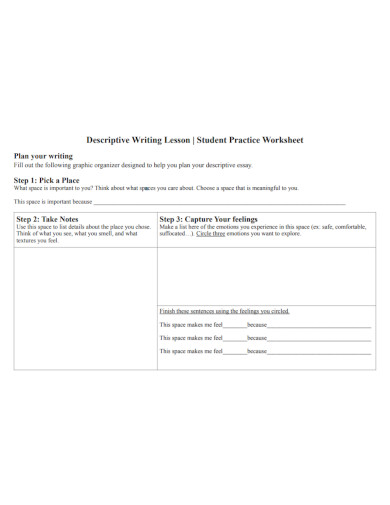
Size: 67 KB
2. Descriptive Activity Writing
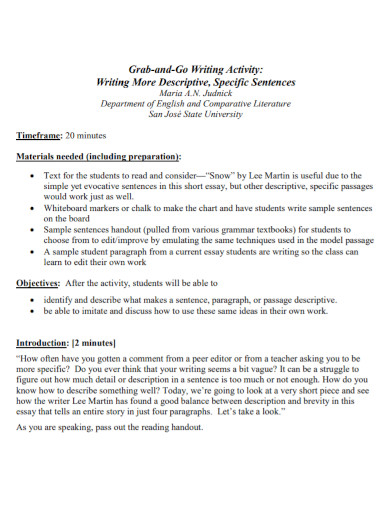
Size: 208 KB
3. Paragraph Descriptive Writing
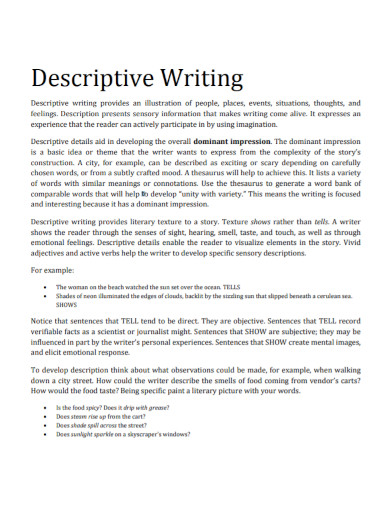
Size: 523 KB
4. Descriptive Critical Writing
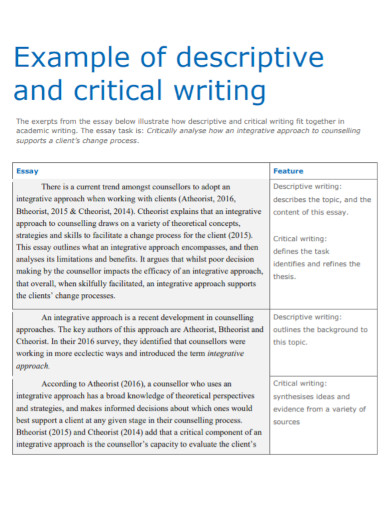
Size: 217 KB
5. Top Grade Descriptive Writing

Size: 78 KB
6. Letter Home Descriptive Writing
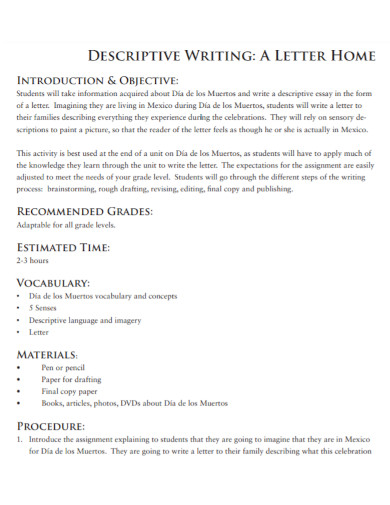
Size: 132 KB
7. Example of Descriptive Writing
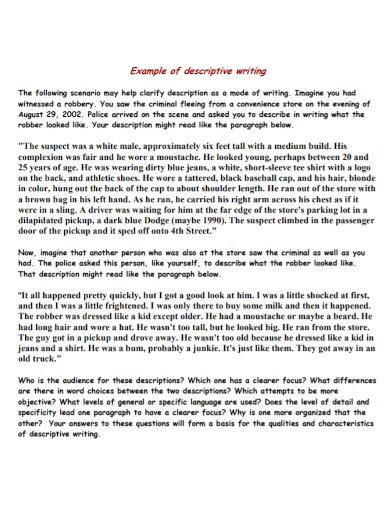
Size: 25 KB
8. Descriptive Writing Assignment
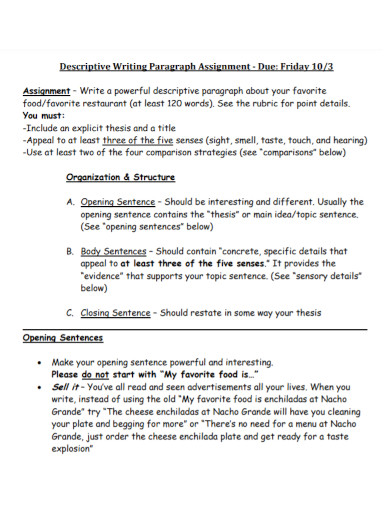
Size: 168 KB
9. Literacy Descriptive Writing
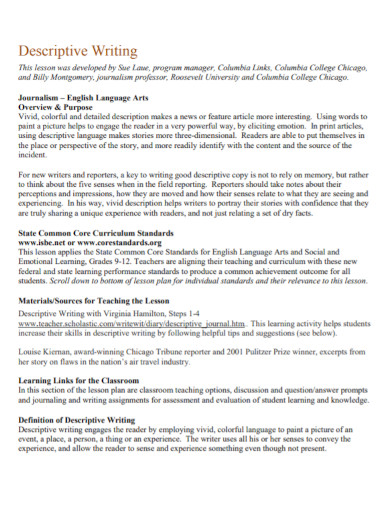
Size: 337 KB
10. Printable Descriptive Writing
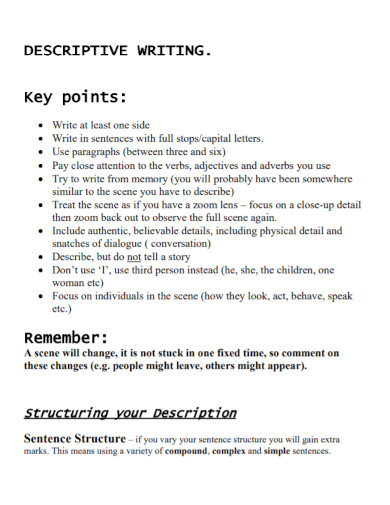
Size: 372 KB
11. Descriptive Writing Skill Sheet

Size: 384 KB
12. Beach Descriptive Writing
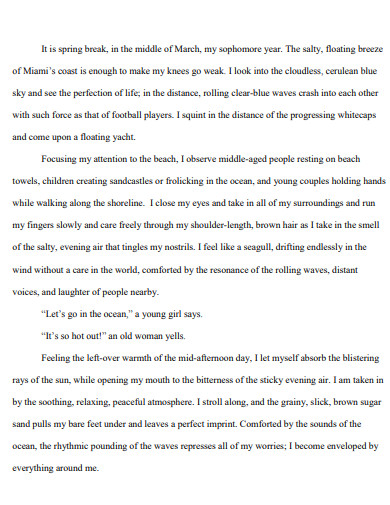
Size: 65 KB
13. 9 Grade Descriptive Writing
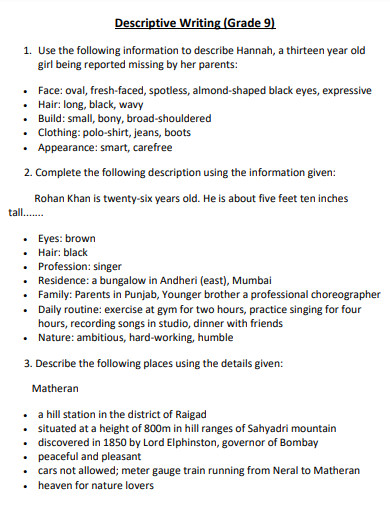
Size: 96 KB
14. Forest Descriptive Writing
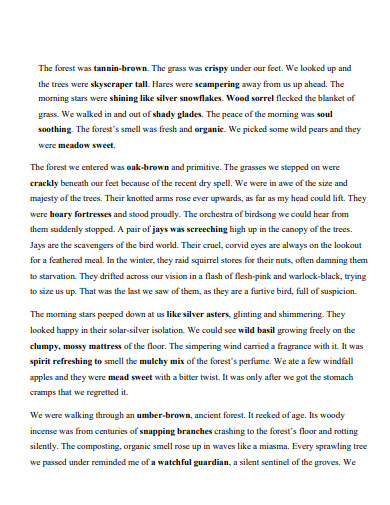
Size: 102 KB
15. Descriptive Writing 5 Senses
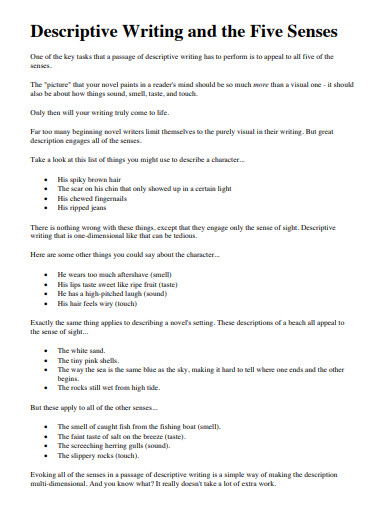
Size: 61 KB
16. Short Descriptive Writing
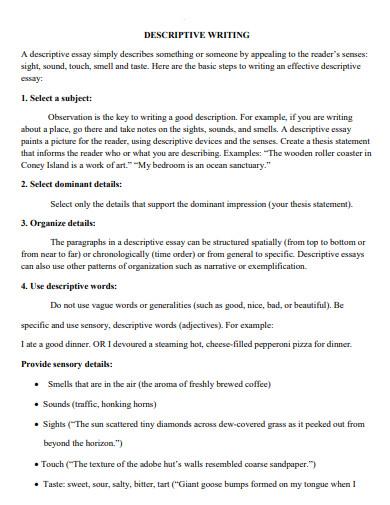
Size: 133 KB
17. Grade 3 Descriptive Writing

Size: 255 KB
18. Descriptive Paragraph Writing
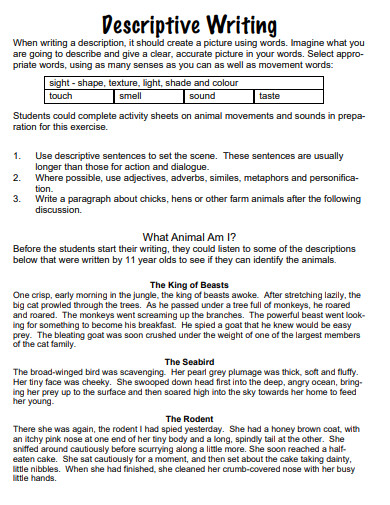
Size: 15 KB
19. Descriptive Essay Writing
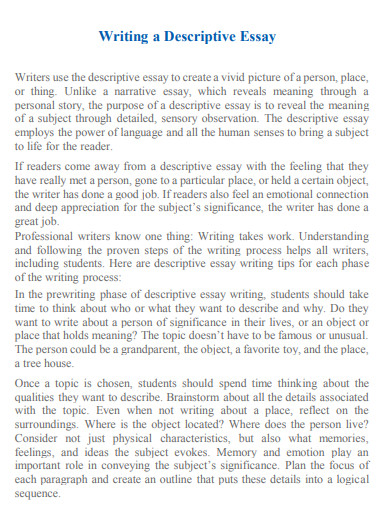
20. Creative Descriptive Writing

Size: 298 KB
21. School Descriptive Writing
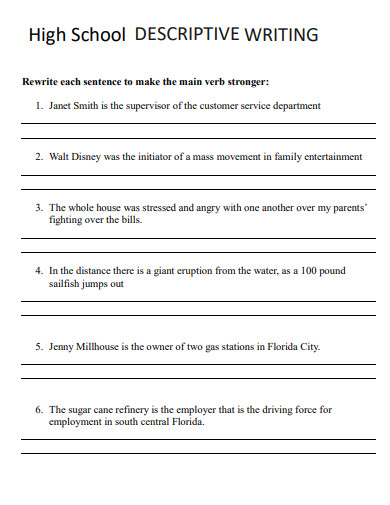
22. Descriptive Story Writing
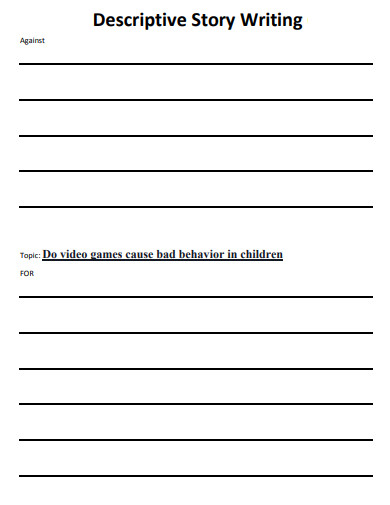
Size: 222 KB
23. Summer Descriptive Writing
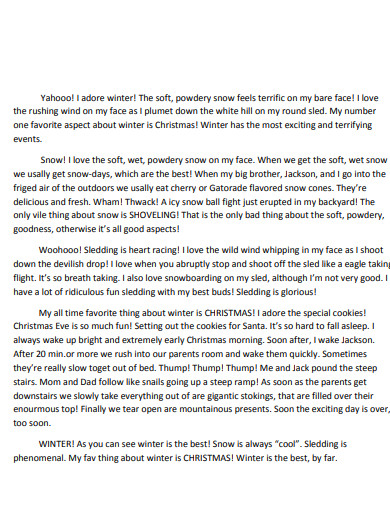
Size: 120 KB
24. Person Descriptive Writing
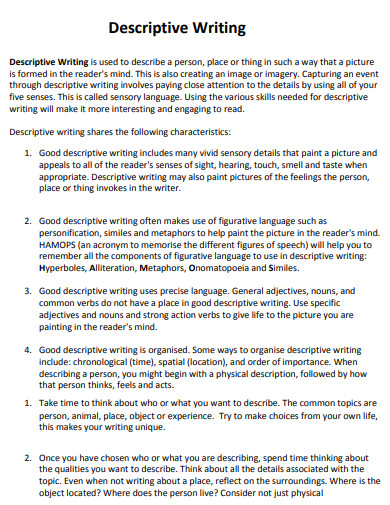
Size: 85 KB
25. Simple Descriptive Writing
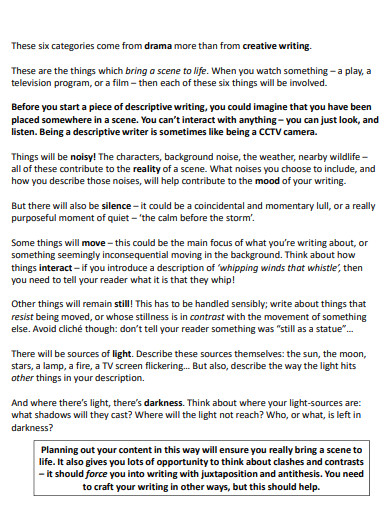
26. Simple Descriptive Writing

27. Teaching Descriptive Writing

Size: 424 KB
28. Descriptive Writing Worksheets
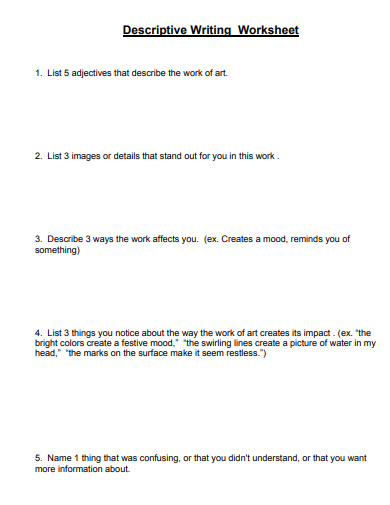
Size: 436 KB
29. Descriptive Writing Rubic
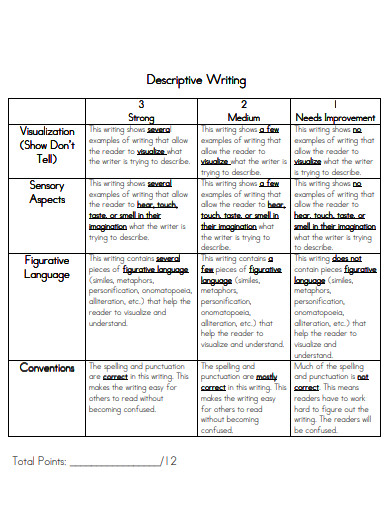
Size: 16 KB
30. Descriptive Writing in PDF
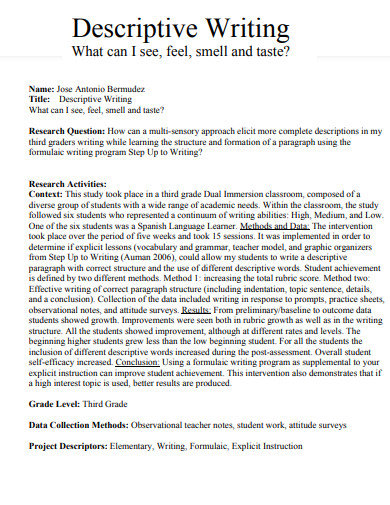
What is Descriptive Writing?
Descriptive writing is defined as a type of writing that gives appropriate description of a place, person, thing or an event. The description should be clear in a way that the readers would be able to imagine what it looks like. It is like watching a beautiful painting expressed in words.
Descriptive writing plays an essential role in writing essays. It will give you the opportunity to communicate with your readers rather than giving them a plain explanation of the contexts. If you want to achieve a good descriptive writing skills, simply find an avenue to interact with your readers.
What are the Characteristics of a Good Descriptive Writing?
There is an involvement of the five senses and these senses refers to the sense of sight, sound, taste, touch and even smell.
Descriptive writing (sense of sight)
This allows your readers to see by means of words. Try to look at the example below taken from a winning novel.
‘ I could picture the smooth oval of Laura’s face, her neatly pinned chignon, the dress she would have been wearing: a shirtwaist with a small rounded collar, in a sober color – navy blue or steel grey or hospital-corridor green. Penitential colors – less like something she’d chosen to put on than something she’d been locked up in.’ (The Blind Assassin, p. 4)
Descriptive writing (sense of sound)
This simply means describing a sound.
Here is an example:
Her high-pitched voice annoys me.
The instruments sounded lightly-compressed as they tried to play an alternating rhythm.
Descriptive writing (sense of taste)
It might become a little complicated when you are going to describe the kind of taste. You are to describe a taste only when the characters use their mouth or tongue in a specific scene. Consider the examples below:
My classmate gave me a very sweet bar of chocolate from Canada.
I overpoured the salt on my fries. Now it tastes very salty.
Descriptive writing (sense of touch)
This will make you feel what the character feels when he or she touches something. It may be an object or a person. It may be referring to the texture or the type of feeling an object or someone gives to you.
For example,
I make it as a habit to run my fingers through my cracked lips.
I can feel his soft skin as he began to touch my hand.
Descriptive writing (sense of smell)
All of us can instantly remember a certain event in the past or a person when we accidentally come across of such a familiar scent. Describing what the character smelled in the story is like imagining what type of smell it is. Well, it is like going to be more specific like any other description does.
My newly bought perfume has a sweet scent.
I don’t like eating durian fruit. It has a very pungent odor.
2. It is much more pleasing to use figures of speech.
The use of figures of speech makes your content more creative. You may use it when writing novels that would surely make your readers want to read more. Here are some examples written by famous authors:
“Her voice… creaked like the hinges of a rusty iron gate.” – Stefan Zweig
“Voice like a coyote with bronchitis.” – O. Henry
3. Arrange your descriptions in chronological order.
It is best to supply descriptions in a well-arranged manner. Readers would prefer writings that are pleasant to read. You may want to describe something starting from its appearance down to its other aspects.
An Example of a Descriptive Essay
On a hot summer, Berlin and I decided to go to the nearest beach in our town. It was a typical boring day where we were supposed to do some chores but quite lazy to do so. Berlin is my best friend. He is almost six feet tall with muscles that were perfectly toned. I am just a typical college kid who has an average height and definitely loves the idea of dancing.
We were at the beach when we saw a huge dog coming our way. I thought it was going to bite me so I ran as fast as I could. I can hear Berlin’s annoying laugh and he even has the time to record what just happened. It turns out that the dog wants to play with me. He is such an adorable dog. He has a red collar on his neck labeled “Kobe”. I guess that was his name.
I decided to take a quick swim. I can feel the cold water on my skin and it feels so refreshing. I’ve always wanted to have a break like this. I took a glance at Berlin and the dog. They were enjoying each other’s company. This is one of my best days!
What are the forms of descriptive writing?
It can be writing for a person, writing for a place, or writing for an object.
How many words do you need in descriptive writing?
There is no limit in words. It depends on your professor or it depends on you.
Is it necessary to use difficult words when describing something?
You may use simple words to make it easy for the readers to understand.
AI Generator
Text prompt
- Instructive
- Professional
10 Examples of Public speaking
20 Examples of Gas lighting

IMAGES
VIDEO
COMMENTS
Here are some examples of descriptive writing: 1. The Beach: The sun was setting, casting a warm golden glow over the calm waters of the ocean. The sound of the waves crashing against the shore was soothing, and the smell of salt water filled the air. The sand was warm and soft under my feet, and I could feel the gentle breeze blowing through ...
Descriptive writing helps the reader visualize the person, place, thing, or situation being described. When a text conjures a vivid, sensory impression in the reader's mind, not only does it make the writing more interesting to read; it helps the reader understand the text better and recognize the author's intention more clearly.
Descriptive Paragraph Example 20: The snow fell softly from the sky, blanketing the world in a thick layer of white. C crystalline frost covered trees, and icicles hung from rooftops, their needles glistening in the pale moonlight. Everything was still and silent; it felt like I was the only living soul for miles.
Descriptive writing uses details and the five senses to describe a person, place, thing, or event. Proper word choice and the use of adjectives are very important for the reader to create a picture in their mind. Similes and onomatopoeia (sound words) are some other examples of descriptive writing. Basic Sentence: The leaf fell off the tree.
Descriptive Essay Example for Grade 6. Descriptive essays are frequently assigned to school students. This type of essay helps the students enhance their writing skills and helps them see things in a more analytical way. If you are a 6 grader and looking for a good descriptive essay example, you are in the right place.
Descriptive writing is writing in which the author's intent is to create a vivid image of what he/she is describing in the mind of the reader. It relies on the author using detailed descriptions ...
Descriptive Writing Prompts with Nonfiction Doggie Lingo (Grades 2-6) Oil in the Gulf (Grades 3-4; Interest Level: Grades 2-9) Pump It Up: All About Your Blood (Grades 3-4) P.U. Plants (Grades 3-4; Interest Level: Grades 4-6) Crazy Cars: Wild and Wacky Rides (Grades 3-4; Interest Level: Grades 4-8)
Descriptive Paragraph Guidelines: • Every sentence must start with a different word. • There are six sentences Sentence 1: Opening sentence sets the scene Sentence 2: sentence starts with an adverb Sentence 3: sentence has a simile Sentence 4: a short and powerful sentence Sentence 5: a long sentence (which can have a metaphor or simile)
Descriptive Writing. Our Descriptive Writing lesson plan for grades 4-6 teaches students to develop the skills needed for descriptive writing. Students practice using the strategies taught in this lesson to enhance their writing. Categories: Downloadable, Language Arts Tags: 4th Grade, 5th Grade, 6th Grade. Description.
Descriptive writing is a powerful tool that enables you to create vivid images in your reader's mind. When you use figurative language and sensory details, it creates an immersive experience for your readers, drawing them into your narrative more fully. The use of metaphors, for example, helps you illustrate similarities in ways that are ...
Microsoft Word - 10 Writing Emergency Lesson Plans RMS 6.doc. Descriptive Writing Prompts: Creating Details Ideas. Using specific details helps the reader to create a picture in their mind. Think about the ideas that you need to include in your writing to help the reader imagine the scene. Start by using sensory details such as seeing, hearing ...
Describing a person is a fun and easy way to start practising the descriptive writing process. When describing a person, children should try to build a full picture by using descriptive language. Twinkl tips: Think about the 5 senses - see, hear, touch, smell, taste. Use descriptive language such as metaphors and similes to paint a visual ...
Grade 6 Writing Task - Descriptive Essay (Term 2) You should always consider the following guidelines when writing descriptive essays: Create a picture in words. Choose words and expressions carefully to create the desired effect. Images of sight, sound,hearing, taste and touch can be used to make your description vivid.
Exercise 1. Decide on an everyday action, say 'making a pot of coffee' and write about it in a descriptive manner. Give yourself 3 words that you're not allowed to use while writing about it. You'll see yourself reaching for the thesaurus, which will help improve your vocabulary. Exercise 2.
If you did, make sure this `slice_type` can be matched with one of your components. Grade 6+ ESL Examples Grammar Rules. Descriptive words help you describe anything you experience in the world. Build the proper vocabulary and test your knowledge with our play-to-learn lists.
EXAMPLES Writing Standards: Grade 6, Standard 3 (W.6.3) Write narratives to develop experiences or events using effective literary techniques, relevant descriptive details, and well-structured sequences. EXAMPLES: Time: Writing Standards: Grade 6, Standard 4 (W.6.4) Produce clear and coherent writing in which
The notes and questions for Descriptive Writing - English Language for Grade 6 - Grade 6 - Notes, Videos & Tests have been prepared according to the Grade 6 exam syllabus. Information about Descriptive Writing - English Language for Grade 6 - Grade 6 - Notes, Videos & Tests covers all important topics for Grade 6 2024 Exam.
An example of a short descriptive essay, written in response to the prompt "Describe a place you love to spend time in," is shown below. Hover over different parts of the text to see how a descriptive essay works. Descriptive essay example. On Sunday afternoons I like to spend my time in the garden behind my house.
Delightful Descriptive Writing Exercises and Worksheets Descriptive writing is an attempt to give a clear description of people, places, objects, or events using descriptive language and informative details. Descriptive writing exercises can include: brainstormingoutliningword sortingsentence writing with picturestransitions exercises 1 Descriptive essay outline template This is an essay ...
Descriptive Essay Topics: Place. Describe your favorite place. Describe your ideal bedroom. Describe the house in which you grew up. Describe what the first house on the moon would look like. Describe some of your favorite places in your hometown. Describe a peaceful place that you've visited. Describe a place that exists only in your ...
For example, My newly bought perfume has a sweet scent. I don't like eating durian fruit. It has a very pungent odor. 2. It is much more pleasing to use figures of speech. The use of figures of speech makes your content more creative. You may use it when writing novels that would surely make your readers want to read more. Here are some ...
Paragraph Writing Topics for Class 6 CBSE Format, Samples, Examples. There are seven steps to writing a successful essay: Pick a topic. …. Prepare an outline or diagram of your ideas. …. Write your thesis statement. …. Write the body. …. Write the introduction. …. Write the conclusion. ….